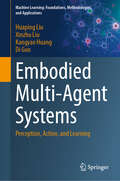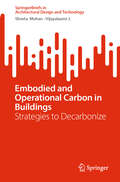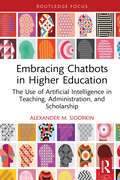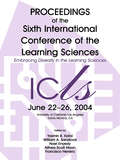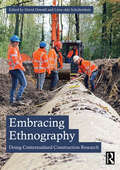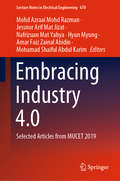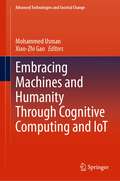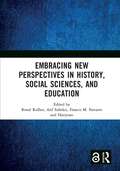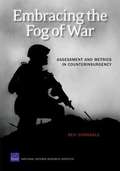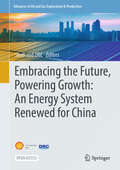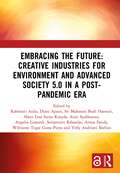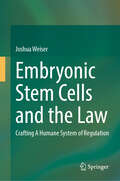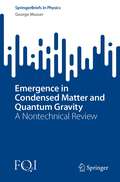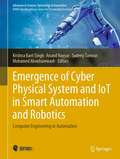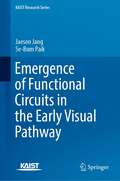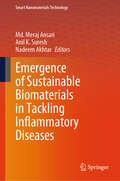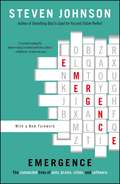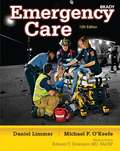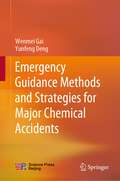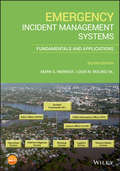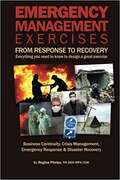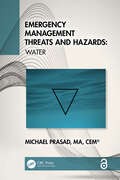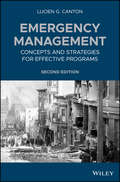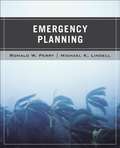- Table View
- List View
Embodied Multi-Agent Systems: Perception, Action, and Learning (Machine Learning: Foundations, Methodologies, and Applications)
by Huaping Liu Di Guo Xinzhu Liu Kangyao HuangIn recent years, embodied multi-agent systems, including multi-robots, have emerged as essential solution for demanding tasks such as search and rescue, environmental monitoring, and space exploration. Effective collaboration among these agents is crucial but presents significant challenges due to differences in morphology and capabilities, especially in heterogenous systems. While existing books address collaboration control, perception, and learning, there is a gap in focusing on active perception and interactive learning for embodied multi-agent systems. This book aims to bridge this gap by establishing a unified framework for perception and learning in embodied multi-agent systems. It presents and discusses the perception-action-learning loop, offering systematic solutions for various types of agents—homogeneous, heterogeneous, and ad hoc. Beyond the popular reinforcement learning techniques, the book provides insights into using fundamental models to tackle complex collaboration problems. By interchangeably utilizing constrained optimization, reinforcement learning, and fundamental models, this book offers a comprehensive toolkit for solving different types of embodied multi-agent problems. Readers will gain an understanding of the advantages and disadvantages of each method for various tasks. This book will be particularly valuable to graduate students and professional researchers in robotics and machine learning. It provides a robust learning framework for addressing practical challenges in embodied multi-agent systems and demonstrates the promising potential of fundamental models for scenario generation, policy learning, and planning in complex collaboration problems.
Embodied and Operational Carbon in Buildings: Strategies to Decarbonize (SpringerBriefs in Architectural Design and Technology)
by Vijayalaxmi J. Shveta MohanThis book offers the basics of embodied and operational carbon while discussing the inclusion of carbon emission in the GBRS at global and national level. This book also critically explores the important topic of embodied and operational carbon of buildings with insights on the strategies to measure and reduce embodied carbon in buildings through a case study and application approach. This approach assesses the impact of embodied carbon on the choice of structural systems, alternate building materials, alternate building technologies and air conditioning system. The impact of these alternate measures in reducing embodied and operational carbon is analyzed by demonstrating its use on a base case building, which is similar to an existing office building in India. The quantified data enables architects and designers to make early design decisions for a more environmentally sensitive approache to sustainable building designs. This book is a valuable resource for students, researchers, and practicing architects in understanding evidence based repercussions of structural systems, use of materials, technology and air conditioning systems to design green and sustainable buildings.
Embracing Chatbots in Higher Education: The Use of Artificial Intelligence in Teaching, Administration, and Scholarship (Routledge Research in Digital Education and Educational Technology)
by Alexander M. SidorkinThis book explores the integration of AI-powered chatbots such as ChatGPT into higher education for instructional and communication purposes. The author emphasizes the responsibility of higher education institutions to equip students with advanced skills for writing with AI assistance, and prepare them for an increasingly AI-driven world.Offering numerous practical tips, the book demonstrates how universities can increase student success, and stem the rising cost of higher education by employing AI tools. The chapters discuss streamlining tasks such as grading, providing feedback, and handling administrative duties, to show how educators can be enabled to focus on more meaningful aspects of their work. The author also reflects on the philosophical and ethical considerations and potential pitfalls of relying on AI in higher education, including concerns about academic integrity and the importance of human input in the learning process. The author offers a responsible and informed approach to incorporating the new powerful tools into the academic landscape.This volume will be a key resource for higher education faculty and administrators seeking to navigate the complex intersection of AI and writing.
Embracing Diversity in the Learning Sciences: Proceedings of the Sixth International Conference of the Learning Sciences
by Yasmin B. Kafai Francisco Herrera William A. Sandoval Noel Enyedy Althea Scott NixonMore than a decade has passed since the First International Conference of the Learning Sciences (ICLS) was held at Northwestern University in 1991. The conference has now become an established place for researchers to gather. The 2004 meeting is the first under the official sponsorship of the International Society of the Learning Sciences (ISLS). The theme of this conference is "Embracing Diversity in the Learning Sciences." As a field, the learning sciences have always drawn from a diverse set of disciplines to study learning in an array of settings. Psychology, cognitive science, anthropology, and artificial intelligence have all contributed to the development of methodologies to study learning in schools, museums, and organizations. As the field grows, however, it increasingly recognizes the challenges to studying and changing learning environments across levels in complex social systems. This demands attention to new kinds of diversity in who, what, and how we study; and to the issues raised to develop coherent accounts of how learning occurs. Ranging from schools to families, and across all levels of formal schooling from pre-school through higher education, this ideology can be supported in a multitude of social contexts. The papers in these conference proceedings respond to the call.
Embracing Ethnography: Doing Contextualised Construction Research
by David Oswald Léon Olde ScholtenhuisThis book calls for those interested in robust construction research to embrace ethnography – in all its forms, including rapid ethnographies, ethnographic-action research, autoethnography, as well as longer-term ethnographies.The diversification of ethnographic approaches, as well as ethnographers, will lead to rich insights that can advance the industry theoretically and practically. We share experiences, key considerations and recommendations from leading construction ethnographic researchers from around the world to provide discussion, reflection and understanding into doing ethnography in the construction industry.This book is aimed at academics, students, consultants, editors, reviewers, policymakers, funders and others interested in robust research in the construction industry and built environment but will also be useful for those undertaking research within organisations in other industries.
Embracing Industry 4.0: Selected Articles from MUCET 2019 (Lecture Notes in Electrical Engineering #678)
by Hyun Myung Nafrizuan Mat Yahya Mohd Azraai Mohd Razman Jessnor Arif Mat Jizat Amar Faiz Zainal Abidin Mohamad Shaiful Abdul KarimThis book highlights selected articles from the electrical engineering track, with a focus on the latest trends in electrical and electronic engineering toward embracing Industry 4.0, as part of the Malaysian Technical Universities Conference on Engineering and Technology—MUCET 2019. The event brings together researchers and professionals in the fields of engineering, research, and technology, and provides a platform for future collaborations and exchanges.
Embracing Machines and Humanity Through Cognitive Computing and IoT (Advanced Technologies and Societal Change)
by Xiao-Zhi Gao Mohammed UsmanThis book sheds light on systems that learn extensively, with purpose and naturally interact with humans. Improving operations and increasing competitive differentiation among manufacturing organizations by harnessing the power of cognitive abilities, IoT can help build and influence the flow of information—making the shop floor more cognitive through effective processing, analysis, and operational optimization. Now we are seeing the first-hand potential of cognitive computing—its ability to transform businesses, governments, and society. The real potential of the cognitive age can be realized by combining data analysis and statistical reasoning of machines with uniquely human qualities, such as self-directed goals, common sense, and moral values, improving operations and increasing competitive differentiation among manufacturing organizations. By harnessing the power of cognitive abilities, IoT can help build and influence the flow of information—making the shop floor more cognitive through effective processing, analysis, and operational optimization. Cognitive initiatives come in all shapes and sizes, from change to strategy and everything in between. What most successful projects have in common, no matter how ambitious, is they start with a clear view of what technology can do. Therefore, the first job of a cognitive scientists is to gain a firm understanding of cognitive abilities, as presented in this book.
Embracing New Perspectives in History, Social Sciences, and Education: Proceedings of the International Conference on History, Social Sciences, and Education (ICHSE 2021), Malang, Indonesia, 11 September 2021
by Francis M. Navarro Ronal Ridhoi Arif Subekti HariyonoThis book provides a collection of articles resulting from the International Conference on History, Social Sciences, and Education (ICHSE), which was held on 11 September 2021. The Department of History of Malang State University choose "Embracing New Perspectives in History, Social Sciences, and Education" as the main topic, and elaborates on five subthemes: 1) new trends in historical research; 2) formulation of new perspectives in history, social sciences, and education; 3) transdisciplinary research in history, social sciences, and education; 4) innovations in historical and social science learning during pandemics; 5) New ideas in the research and practice of social sciences and education. This seminar was open to international academics.This book presents new perspectives on methodology, methods, theory, and themes on history, social sciences, and education research from various perspectives on methodology and historiography. Now, history is not only about politics, economy and military, but also about environment, social, education, culinary, and so on. This book will be useful for students, historians, and the general public, in recording the development of Indonesian historical writing perspectives.
Embracing the Fog of War: Assessment and Metrics in Counterinsurgency
by Ben ConnableThe unpredictable counterinsurgency environment challenges centralized, quantitative campaign assessment. A comprehensive examination of the centralized, quantitative approach to assessment, as described inthe literature and doctrine and applied in two primary case studies (Vietnam and Afghanistan), reveals weaknesses and gaps and proposes an alternative process: contextual assessment.
Embracing the Future, Powering Growth: An Energy System Renewed for China (Advances in Oil and Gas Exploration & Production)
by Shell International B.V. Development Research Centre of the State Council (DRC) of People’s Republic of ChinaTo build a new energy system is the key towards China's goal of carbon emissions peak and achieving carbon neutrality. The new energy system will reshape the conventional energy system in an integrated and revolutionary way. It will not only bring about major changes in energy production, utilization and consumption, as well as emissions of greenhouse gas (GHG) and local pollutants, but also have profound implications on technological innovation and economic development. Based on quantitative and systematic analysis, this study depicts the energy system by 2030 and by 2060, analyzes the impacts of the energy system on economic and social development, studies and judges the key risk points, and proposes the path and policy system for building a new energy system.This is an open access book.
Embracing the Future: Proceedings of the 8th Bandung Creative Movement International Conference on Creative Industries (8th BCM 2021), Bandung, Indonesia, 9 September 2021
by Rahmiati Aulia Diani Apsari Budi Haswati, Sri Maharani Surya Rusyda, Hana Faza Aisyi Syafikarani Angelia Lionardi Setiamurti Rahardjo Ariesa Farida Guna Putra, Wibisono Tegar Yelly Andriani BarlianBy delivering the mindful writings from our selected authors, this book portrays one big idea: a new Human-Centered society that balances economics to resolve problems, especially in the use of an integrated area in cyberspace, physical space, and how it impacts the creative industries. Through The 8th Bandung Creative Movement, scholars from 15 Universities around the Asian and European countries have discussed this issue where Human-Centered society became the main consideration in the development.Three topics are presented to the readers. Firstly, "Sustainable Cities and Communities" explores the sub-fields that construct a more sustainable environment for society post-pandemic era, such as technologies, transportation, interior design, architecture, urban planning, etc. While "Art and Design: Recontextualization of Nusantara Tradition and Indigenous Culture" concerned the novel perspectives on recognizing cultural aspects that shape the face of creative industry, from cultural identity, visual and performing arts, pop culture to language and media. The last topic, "Changes and Dynamics in The Creative Industries," reviews the creative approach toward the industry's current trends, including marketplace, destination branding, or digital culture ecosystem. This book will enrich the mind of everybody who is an enthusiast of innovative research on creative industries, human-centered technologies, environmental design, and excellent society 5.0 post-pandemic era.
Embryonic Stem Cells and the Law: Crafting A Humane System of Regulation
by Joshua WeiserThis book deals with the research and use of embryonic stem cells to combat a number of diseases and the legal limitations, arising mostly from bioethical concerns regarding human life. Using the New Haven problem and policy-oriented method of jurisprudence, the author thoroughly explains the scientific and technological parameters and promise of this medical innovation and its alternatives as well as the conflicting claims and past decisions regarding its legal and moral acceptability in international and comparative perspective. International law, EU and regional human rights law, as well as individual countries’ laws across the globe are covered, ending with American law on the federal and state levels. The book concludes with a recommendation of humane regulation, and a draft federal statute as a model form of regulation that would allow the beneficial research and use of this technology.
Emergence in Condensed Matter and Quantum Gravity: A Nontechnical Review (SpringerBriefs in Physics)
by George MusserThis book surveys the science at a semipopular, Scientific American-level. It is even-handed with regard to competing directions of research and philosophical positions. It is hard to get even two people to agree on anything, yet a million billion water molecules can suddenly and abruptly coordinate to lock themselves into an ice crystal or liberate one another to billow outwards as steam. The marvelous self-organizing capacity of matter is one of the central and deepest puzzles of physics, with implications for all the natural sciences. Physicists in the past century have found a remarkable diversity of phases of matter—and equally remarkable commonalities within that diversity. The pace of discovery has, if anything, only quickened in recent years with the appreciation of quantum phases of matter and so-called topological order. The study of seemingly humdrum materials has made contact with the more exotic realm of quantum gravity, as theorists realize that the spacetime continuum may itself be a phase of some deeper and still unknown constituents. These developments flesh out the sometimes vague concept of the emergence—how exactly it is that complexity begets simplicity.
Emergence of Cyber Physical System and IoT in Smart Automation and Robotics: Computer Engineering in Automation (Advances in Science, Technology & Innovation)
by Krishna Kant Singh Sudeep Tanwar Anand Nayyar Mohamed AbouhawwashCyber-Physical Systems (CPS) integrate computing and communication capabilities by monitoring and controlling the physical systems via embedded hardware and computers. This book brings together new and futuristic findings on IoT, Cyber Physical Systems and Robotics leading towards Automation and solving issues of various critical applications in Real-time. The book initially overviews the concepts of IoT, IIoT and Cyber Physical Systems followed by various critical applications and discusses the latest designs and developments that provide common solutions for the convergence of technologies. In addition, the book specifies methodologies, algorithms and other relevant architectures in various fields that include Automation, Robotics, Smart Agriculture and Industry 4.0.The book is intended for practitioners, enterprise representatives, scientists, students and Ph.D Scholars in hopes of steering research further towards cyber physical systems design and development and implementation across various domains. Additionally, this book can be used as a secondary reference, or rather one-stop guide, by professionals for real-life implementation of cyber physical systems.The book highlights:• A Critical Coverage of various domains: IoT, Cyber Physical Systems, Industry 4.0, Smart Automation and related critical applications.• Advanced elaborations for target audiences to understand the conceptual methodology and future directions of cyber physical systems and IoT.• An approach towards Research Orientations to enable researchers to point out areas and scope for implementation of Cyber Physical Systems in several domains for better productivity.
Emergence of Functional Circuits in the Early Visual Pathway (KAIST Research Series)
by Jaeson Jang Se-Bum PaikThis book discusses the emergence of diverse functional organizations in the visual pathway which could be spontaneously and solely initiated by the random feedforward wiring of neural circuits. It demonstrates that the structure of ON and OFF retinal ganglion cell (RGC) mosaics is projected onto V1 by retino-cortical feedforward mapping to induce higher cognitive functions. This book will be beneficial for both theoretical and experimental neuroscientists, as well as for researchers using brain-inspired neural network models.
Emergence of Sustainable Biomaterials in Tackling Inflammatory Diseases (Smart Nanomaterials Technology)
by Anil K. Suresh Nadeem Akhtar Md. Meraj AnsariThis book presents the latest technology of sustainable nanomaterials for applications as drug delivery cargos in tackling various inflammatory diseases. The chapters in this book describe nanotechnology-based drug delivery strategies, the mechanistic insights of nanoformulations and their application in managing inflammation diseases such as rheumatoid arthritis, ulcerative colitis, cancer and neurological disorder. It looks into the challenges of using nanomaterials-based smart materials for enhanced therapeutic efficacy while maintaining safe and sustainable procedures. The book is divided into three main sections: A) Fundamental of smart nanocarriers and nanoformulations targeted drug delivery in inflammatory disease; B) Smart nano drug delivery therapy- an emerging approach towards inflammatory diseases and C) Novel nano delivery strategies in targeting major inflammatory diseases. The book targets early researchers and clinical practitioners who are interested in the management and treatment of inflammatory diseases using nanotechnology-based drug delivery systems.
Emergence: The Connected Lives of Ants, Brains, Cities, and Software
by Steven JohnsonIn the tradition of Being Digital and The Tipping Point, Steven Johnson, acclaimed as a "cultural critic with a poet's heart" (The Village Voice), takes readers on an eye-opening journey through emergence theory and its applications.<P> A NEW YORK TIMES NOTABLE BOOK<P> A VOICE LITERARY SUPPLEMENT TOP 25 FAVORITE BOOKS OF THE YEAR<P> AN ESQUIRE MAGAZINE BEST BOOK OF THE YEAR <P> Explaining why the whole is sometimes smarter than the sum of its parts, Johnson presents surprising examples of feedback, self-organization, and adaptive learning. How does a lively neighborhood evolve out of a disconnected group of shopkeepers, bartenders, and real estate developers? How does a media event take on a life of its own? How will new software programs create an intelligent World Wide Web? <P> In the coming years, the power of self-organization -- coupled with the connective technology of the Internet -- will usher in a revolution every bit as significant as the introduction of electricity. Provocative and engaging, Emergence puts you on the front lines of this exciting upheaval in science and thought.
Emergencies in Public Law
by Karin LoevyDebates about emergency powers traditionally focus on whether law can or should constrain officials in emergencies. Emergencies in Public Law moves beyond this narrow lens, focusing instead on how law structures the response to emergencies and what kind of legal and political dynamics this relation gives rise to. Drawing on empirical studies from a variety of emergencies, institutional actors, and jurisdictional scales (terrorist threats, natural disasters, economic crises, and more), this book provides a framework for understanding emergencies as long-term processes rather than ad hoc events, and as opportunities for legal and institutional productivity rather than occasions for the suspension of law and the centralization of response powers. The analysis offered here will be of interest to academics and students of legal, political, and constitutional theory as well as to public lawyers and social scientists.
Emergency Care (12th Edition)
by J. David Bergeron Daniel Limmer Michael F. O'Keefe Edward T. Dickinson Harvey D. Grant Robert H. Murray Jr.Emergency Care, Twelfth Edition, has set the standard for EMT training for over 30 years. Updated with the latest research and developments in emergency medical services, this edition meets the 2010 American Heart Association guidelines for CPR and ECC, providing all the practical information students need to succeed in the classroom and in the field. Using the National EMS Education Standards as a foundation, this edition goes beyond the Standards to provide the most current, accurate reflection of EMS practice today. Getting students to think like an EMT, the text integrates scientific principles in a way that's easy to understand, and a host of critical thinking features-including a new chapter, "Critical Thinking and Decision Making,"-helps students learn key concepts while getting a dose of the reality of being an EMT.
Emergency Guidance Methods and Strategies for Major Chemical Accidents
by Wenmei Gai Yunfeng DengThis book serves as a great reference for engineering technicians and researchers in a wide range of fields, including emergency management, public safety science, risk management, emergency communication, and transportation optimization. This book carried out researches about the public emergency behavior guidance strategies and methods for major chemical accidents. They put forward the classification model of emergency evacuation events, the selection of public emergency guidance strategies, the quantitative assessment of emergency response risk as well as the characteristics of sub-regional evacuation based on a wide range of theories, including safety engineering, social science, behavioral science, etc. Methods, such as case statistics and analysis, field research as well as modeling and simulation, were applied. Five chapters were covered by the book, including introduction of study background, statistics and analysis of hazardous chemical leakage accidents and emergency evacuation response in China in recent ten years, shelter-in-place risk assessment for high-pressure natural gas wells with hydrogen sulphide, dynamic emergency route planning, and characteristics analysis of sub-regional evacuation.
Emergency Incident Management Systems: Fundamentals and Applications
by Louis N. Molino Sr. Mark S. WarnickThe second edition was to be written in order to keep both reader and student current in incident management. This was grounded in the fact that incident management systems are continually developing. These updates are needed to ensure the most recent and relevant information is provided to the reader. While the overall theme of the book will remain the same of the first edition, research and research-based case studies will be used to support the need for utilizing emergency incident management systems. Contemporary research in the use (and non-use) of an incident management system provides clear and convincing evidence of successes and failures in managing emergencies. This research provides areas where first responders have misunderstood the scope and use of an emergency incident management system and what the outcomes were. Contemporary and historical (research-based) case studies in the United States and around the globe have shown the consequences of not using emergency incident management systems, including some that led to increased suffering and death rates. Research-based case studies from major incidents will be used to show the detrimental effects of not using or misunderstanding these principles. One of the more interesting chapters in the new edition is what incident management is used around the world.
Emergency Management Exercises from Response to Recovery: Everything You Need to Know to Design a Great Exercise
by Regina PhelpsExercises are a mainstay in the field of emergency management and business continuity planning. Although many companies conduct exercises, and the organizers may be emergency response subject matter experts, they do not excel in the discipline of designing and conducting the actual exercise – which means they simply don’t get the best results out of their effort. <p><p> This thoughtful book starts with a “silly little question”: Why are we doing this? What seems like a simple query is actually one of the keys to get the most out of every exercise you design. This text peels back the design process with the goal of creating the best experience possible. Whether you are developing a simple tabletop exercises or working on a full-scale extravaganza that resembles a Hollywood movie, this book will provide you with gems of wisdom that will make your next exercise sizzle. An internationally recognized expert in exercise design, Regina Phelps shares many of her secrets to ensure your exercise success.
Emergency Management Threats and Hazards: Water
by Michael PrasadEmergency Management Threats and Hazards: Water is a resource guidebook, which bridges the work of the emergency management practitioners and academic researchers, specifically for water-related incidents. Practitioners typically follow a disaster phase cycle of preparedness/protection/prevention, response, recovery, and mitigation – all of which have distinct actions and missions to reduce or eliminate adverse impacts from both threats and hazards. Academics will find the connections to allied fields such as meteorology, hydrology, homeland security, healthcare, and more. The book examines many of the distinct differences and variances within the specific scope of water-related incidents, crises, emergencies, and disasters. It provides examples and practical strategies for protection/prevention, response, recovery, and mitigation against adverse impacts to people, property, and organizations. It is also organized in the same construct used by emergency management practitioners (incident command system elements, disaster cycle phases, etc.), which will help align the academic world of emergency management education to both the practice and the training in the emergency management field. Takes a global view on threats and hazards, as well as their solutions. Provides a single repository of the majority of water-related incidents and provides a "how to" guide for resilience. Identifies cascading impacts and provides checklists for resolutions. Includes numerous case studies organized by threat and hazard. Chapter 2 of this book is freely available as a downloadable Open Access PDF at http://www.taylorfrancis.com under a Creative Commons [Attribution-NonCommercial-NoDerivatives (CC-BY-NC-ND)] 4.0 license.
Emergency Management: Concepts and Strategies for Effective Programs
by Lucien G. CantonProvides a comprehensive examination of emergency management and offers concepts and strategies for creating effective programs This book looks at the larger context within which emergency management response occurs, and stresses the development of a program to address a wide range of issues. Not limited to traditional emergency response to natural disasters, it addresses a conceptual model capable of integrating multiple disciplines and dealing with unexpected emergencies. Emergency Management: Concepts and Strategies for Effective Programs, Second Edition starts by focusing on the three pillars on which successful emergency management is based: an understanding of history, knowledge of social science research, and technical expertise in emergency management operations. It provides insight as to how emergency management has evolved and suggests reasons why the current method of response planning doesn’t work as well as it should. The book then goes on to discuss establishing and administering the emergency management program. It looks at the analysis of risk as the basis for strategy development, and considers both the traditional macro view of hazard identification and analysis as well as the micro view required for continuity planning. Strategy development is examined next, followed by coverage of planning process, techniques and methods. The book finishes with chapters on coordinating response, leading in crisis, and crisis management. Features two new chapters on the development of national response strategy and leadership in a crisis Incorporates the Principles of Emergency Management adopted by many emergency management professional associations and agencies Encourages the development of an enterprise wide program to address a wide range of potential threats Covers the various phases of comprehensive emergency management Integrates academic research with practical experience and case studies Emergency Management: Concepts and Strategies for Effective Programs is an important book that will benefit students, law enforcement, and state and local emergency managers and planners involved in emergency management.
Emergency Planning
by Ronald W. Perry Michael K. LindellIn order for a community to be truly prepared to respond to any type of emergency, it must develop effective emergency planning. Emergency Planning guides readers through the steps of developing these plans, offering a number of strategies that will help ensure success. It delves into the patterns of human disaster behavior, social psychology, and communication as well as the basics of generic protective actions, planning concepts, implementation, and action.
